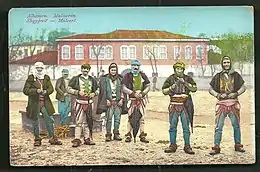Vatër
The vatër (definite Albanian form: vatra) is the domestic hearth in Albanian folklore. The fire of the domestic hearth, zjarri i vatrës, is considered the sustainer of the continuity between the world of the living and that of the dead, and ensures the continuity of the tribe (fis) from generation to generation.[1][2][3]
| Part of a series on the |
| Culture of Albania |
|---|
 |
| Part of a series on |
| Albanian tribes |
|---|
 |
Etymology
The Albanian term vatër, "hearth", "fireplace", is derived from Proto-Indo-European *h₂ehₓ-tr-ehₐ-, and is related to the Avestan atar, "fire".[1][4]
Tradition
The function of the fire of the domestic hearth (zjarri i vatrës) is the sustenance of the continuity between the world of the living and that of the dead. After death, the souls of the ancestors (hije) assume a divine connotation and remain in contact with the family protecting the domestic hearth.[1][2] In Albanian tradition, the fire of the domestic hearth is protected also by Nëna e Vatrës (the Mother of the Hearth), a beneficent deity akin to Greek Hestia and Roman Vesta.[1][2][5] At feasts, people used to practice sacrificial offerings to the deities throwing some of the food they prepared into the fire of the domestic hearth and around the hearth.[6][1]
Zjarri i vatrës also ensures the continuity of the tribe (fis) from generation to generation.[1] In Albanian tradition, indeed, the lineage is identified with an original fire (zjarr); the members of a tribe are the ones who come "from the same fire" (pe një zjarri). The fire burns into the hearth (vatër), where it assumes another connotation besides the primordial concept: the fire of the domestic hearth is considered also as a place of common existence and commensality.[3]
Sources
Citations
- Poghirc 1987, p. 179.
- Tirta 2004, pp. 176, 410.
- De Rapper 2012, pp. 14–15.
- Mallory & Adams 1997, p. 263.
- Monaghan 1997, p. 350.
- Tirta 2004, pp. 177, 179.
Bibliography
- De Rapper, Gilles (2012). "Blood and Seed, Trunk and Hearth: Kinship and Common Origin in southern Albania". In Hemming, Andreas; Kera, Gentiana; Pandelejmoni, Enriketa (eds.). Albania: Family, Society and Culture in the 20th century. LIT Verlag Münster. pp. 79–95. ISBN 9783643501448.CS1 maint: ref=harv (link)
- Mallory, James P.; Adams, Douglas Q., eds. (1997), Encyclopedia of Indo-European Culture, London: Routledge, ISBN 978-1-884964-98-5, (EIEC)CS1 maint: ref=harv (link)
- Monaghan, Patricia (1997). The New Book of Goddesses & Heroines. Llewellyn Publications. p. 324. ISBN 9781567184655.CS1 maint: ref=harv (link)
- Poghirc, Cicerone (1987). "Albanian Religion". In Mircea Eliade (ed.). The Encyclopedia of Religion. 1. New York: MacMillan Publishing Co. pp. 178–180.CS1 maint: ref=harv (link)
- Tirta, Mark (2004). Petrit Bezhani (ed.). Mitologjia ndër shqiptarë (in Albanian). Tirana: Mësonjëtorja. ISBN 99927-938-9-9.CS1 maint: ref=harv (link)